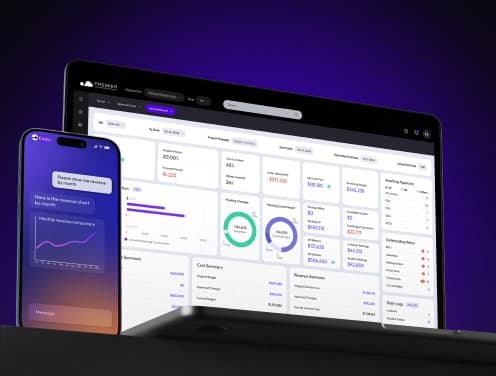
Everything You Need to Know About Constructional Financial Management
The American construction industry brings in $390 billion in revenue each year. This makes construction financial management the most important factor in project success. Many construction companies face major financial hurdles despite this massive scale.
Payment cycles stretch beyond 60 days in the industry. Some subcontractors wait up to 90 days to get paid. Manual data entry in spreadsheets creates a 40% risk of errors that leads to more financial risks. These problems grow bigger because construction projects can last up to 10 years.
Construction financial management helps companies deal with these challenges through systematic budgeting, cost control, and cash flow analysis. This piece covers everything in financial management strategies, digital solutions, and practical approaches that help construction professionals manage project finances better. Readers will discover proven ways to boost their financial operations and project results through budget development and performance measurement.
Fundamentals of Construction Financial Management
Financial management in construction projects needs specialized approaches that set it apart from traditional methods. The average payment cycle extends to 60 days, and some subcontractors wait up to 90 days for payment. These delays create unique challenges for construction businesses.
Core Components of Financial Management in Construction
Construction financial management consists of these fundamental elements:
- Budget Development and Control
- Cost Tracking and Analysis
- Cash Flow Management
- Risk Assessment
- Financial Performance Monitoring
- Payment Schedule Management
These elements combine to form a complete financial framework. Construction financial management software like Premier Construction Software helps merge these components through automated financial reporting and live monitoring capabilities.
Key Stakeholders and Their Roles
Multiple stakeholders play crucial roles in construction financial management:
- CFO/Finance Director: Strategic financial planning, investment decisions
- Project Manager: Day-to-day financial oversight, budget control
- Risk Manager: Financial risk assessment and mitigation
- Construction Manager: Resource allocation, cost monitoring
Financial Management Lifecycle in Construction Projects
The financial management lifecycle covers the project duration, which can extend up to 10 years. This timeline demands different approaches than typical annual reporting systems.
Stakeholders concentrate on budgeting and resource planning during the pre-construction phase. Active cost control and performance monitoring dominate the construction phase. Payment management becomes vital as multiple contractors and suppliers need coordinated financial handling.
Financial reporting builds the foundation for decision-making throughout the project lifecycle. Regular financial analysis helps spot potential issues early. Construction management software streamlines these processes by automating routine tasks and providing live financial data access.
Companies that implement effective financial management strategies often achieve better project outcomes. Smart cash flow management and strategic cost control allow firms to grow their project portfolio without increasing costs significantly.
Construction Project Budget Development
A well-laid-out construction budget guides your project to financial success. Your construction budget outlines the work to be done and breaks down projected costs and available funds over time.
Creating Accurate Cost Estimates
The construction cost estimation process begins with a Work Breakdown Structure (WBS) that divides your project into smaller, manageable components. This method helps you identify all resources and their costs.
Key budget components include:
- Direct costs (labor, materials, equipment)
- Indirect costs (permits, insurance, site security)
- Overhead expenses
- Profit margins
Budget Allocation Strategies
Premier Construction Software lets construction firms track every dollar with immediate financial data access. Project managers can monitor expenses and forecast critical costs precisely.
The budget allocation process focuses on the following:
Cost Category and its typical allocation
- Direct Costs - 65-75%
- Indirect Costs - 15-20%
- Overhead - 10-15%
- Contingency - 5-20%
Risk Assessment and Contingency Planning
Risk assessment in construction budgeting needs careful analysis of variables. Material price changes, labor availability, and weather conditions can affect the budget significantly.
Construction firms set aside between 5% to 20% of the total budget as contingency funds. This financial buffer addresses:
- Unexpected material price increases
- Supply chain disruptions
- Labor shortages
- Weather-related delays
Budget monitoring helps spot differences between projected and actual expenses. Project managers can make quick adjustments through continuous oversight and Work-in-Progress (WIP) accounting to keep the project financially stable.
Premier Construction Software's automated financial reporting systems make budget tracking effortless. Construction firms can grow their project portfolio without increasing costs and keep strict financial control throughout the project lifecycle.
Digital Solutions for Financial Control
Digital solutions play a key role in modern construction financial management. Premier Construction Software gives construction firms detailed tools to manage their financial operations well.
Premier Construction Financial Software Overview
Premier Construction Software brings all financial management features together in one platform. The system handles:
- Revenue Management: Tracks contractor invoices and cash receipts
- Cost Control: Manages job costs and labor expenses
- Financial Reporting: Generates owner contracts and invoicing
- Data Integration: Connects field and accounting teams
Construction firms can reduce manual data entry errors with this software. These errors affect up to 40% of spreadsheet-based operations.
Automated Financial Reporting Systems
Automated systems have transformed construction companies' financial data handling. These systems deliver:
- Up-to-the-minute budget tracking and cost monitoring
- Automated invoice creation and processing
- Instant access to financial performance metrics
- Customizable reporting dashboards
Construction firms can process transactions within a single portal using automated financial reporting systems. This automation helps maintain steady cash flow and ensures vendors get paid on time.
Integration with Project Management Tools
Modern construction financial management depends on strong integration capabilities. Companies see major improvements in their operations when they implement integrated systems.
Financial and project management systems' integration offers several benefits:
- Synchronized data between field operations and accounting
- Better decisions through instant information access
- Better cost management and forecasting
- Efficient subcontractor payment processes
Premier Construction Software lets companies store documents, contracts, drawings, and compliance documents in one secure system. These documents often live in separate systems, which creates inefficiencies and leads to errors.
Construction firms can link their financial data with project management tools of all types through point-to-point integrations. This continuous connection helps track costs and control budgets throughout the project accurately.
Companies can grow their project portfolio without increasing costs using this software. Better resource allocation and well-timed material orders reduce equipment and labor downtime, creating this efficiency.
Performance Measurement Framework
Financial performance measurement is the life-blood of successful construction management. A well-laid-out framework lets construction firms track their financial health through metrics and analytical tools.
Financial KPIs for Construction Projects
Construction companies need to track vital financial indicators that show project success. The gross profit margin shows how well a company handles direct project costs. The net profit margin reveals the percentage of revenue left after all expenses.
Key financial metrics and their respective purposes include:
- Cash Flow: Tracks payment cycles and liquidity
- Cost Variance: Measures budget adherence
- Working Capital: Assesses short-term financial stability
- Revenue Recognition: Monitors project completion value
Data Analytics for Financial Decision Making
Data analytics helps construction firms make smart financial decisions. Companies that use data analytics in their operations perform better than their competitors. Systematic analysis reveals patterns and trends that traditional methods might miss.
Premier Construction Software comes with advanced analytics features for:
- Budget tracking and forecasting
- Resource allocation optimization
- Risk assessment calculations
- Performance trend analysis
Real-time Performance Monitoring
Live monitoring systems give instant updates on project finances. These systems catch problems early before they grow. Construction monitoring shows clear project progress in several areas:
- Quality control assessments
- Timeline adherence
- Supplier performance tracking
- Cost management
- Material usage efficiency
Automated data collection has taken over manual processes and delivers more frequent and complete updates. Live tracking boosts efficiency by streamlining the monitoring process and cuts down time spent on manual reports.
Premier Construction Software's live monitoring features let construction firms track financial metrics continuously. This constant oversight helps companies maintain optimal working capital and handle short-term financial obligations better.
Performance measurement frameworks give construction businesses valuable insights into their operations. The quick ratio reveals a company's ability to pay short-term debts. Companies should look at this metric among other financial indicators to get a full picture of financial health.
Construction firms that use complete performance measurement systems see better project outcomes. They can spot areas to optimize operations and cut costs by tracking labor productivity through metrics like percentage of labor downtime.
Cash Flow Optimization Strategies
Cash flow management plays a crucial role in helping construction businesses survive. Construction companies face unique challenges because payment cycles stretch between 60 to 90 days.
Payment Schedule Management
Payment schedules are the foundations of financial stability in construction projects. A well-laid-out payment schedule has:
- Progress Payments - Medium to large projects
- Milestone-Based - Stage-specific releases
- Time-Based - Equal periodic distributions
- Completion-Based - Regular interval payments
Premier Construction Software gives construction firms the tools to manage these payment schedules through automated tracking and notifications. This automation cuts down payment delays and makes cash flow more predictable.
Working Capital Optimization
Working capital keeps construction operations running. The formula stays simple: Working Capital = Current Assets – Current Liabilities.
These strategies help optimize working capital:
- Regular reviews of accounts receivable aging
- Inventory turnover monitoring
- Assessment of prepaid expenses
- Strategic management of current liabilities
Construction firms can get additional working capital in several ways. Companies with strong financial statements often qualify for revolving credit facilities at competitive rates - typically prime plus 1%.
Cash Flow Forecasting Techniques
Cash flow forecasting lets construction businesses predict and prepare for future financial needs. Construction companies should start with a resolved cash balance when creating their first forecast.
Effective forecasting needs these key elements:
- Listing all incoming money sources
- Documenting operational expenses
- Using historical project data
- Factoring seasonal variations
- Including contingency plans
Premier Construction Software provides immediate data access for accurate forecasting. Construction firms can spot trends early and build cash reserves for potential business disruptions.
Construction companies that manage cash flow properly can expand their project portfolio without raising costs. They maintain healthy cash flows throughout project lifecycles by cutting equipment and labor downtime and ordering materials at the right time.
Payment terms and time-scales in the construction industry substantially affect project cash flow profiles. Companies should monitor interim valuations against cash flow projections regularly to see if works are ahead or behind schedule.
Conclusion
Financial management is the life-blood of project success in America's $390 billion construction industry. Construction professionals who want to succeed in this competitive sector must become skilled at financial management techniques.
Premier’s construction management software offers a powerful solution that automates financial processes and streamlines operations while reducing manual errors. The platform's up-to-the-minute data analysis helps construction firms keep optimal cash flow through automated payment tracking and precise budget control.
Construction companies achieve remarkable results when they implement these financial management strategies. Better budget development, performance measurement, and cash flow optimization create improved project outcomes. Digital solutions have revolutionized how construction firms handle their finances. Companies can now expand their project portfolios while they retain control of costs.
Construction financial management's future lies in increased automation and analytical insights. Construction professionals who welcome these advanced financial management practices set themselves up for lasting growth. Financial precision determines project outcomes in this industry, making these practices crucial for success.





















